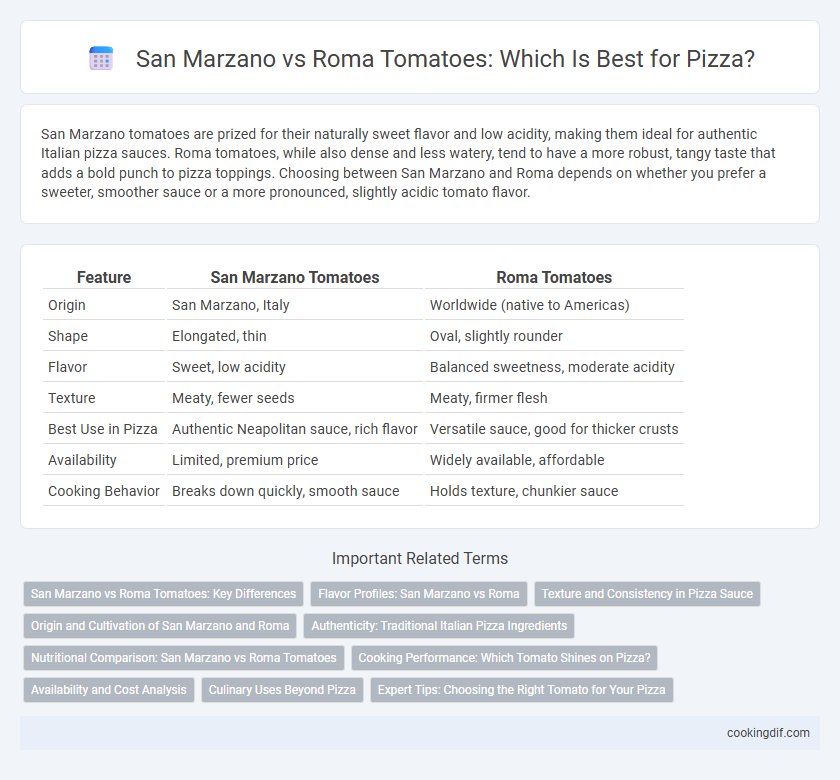San Marzano tomatoes are prized for their naturally sweet flavor and low acidity, making them ideal for authentic Italian pizza sauces. Roma tomatoes, while also dense and less watery, tend to have a more robust, tangy taste that adds a bold punch to pizza toppings. Choosing between San Marzano and Roma depends on whether you prefer a sweeter, smoother sauce or a more pronounced, slightly acidic tomato flavor.
Table of Comparison
| Feature | San Marzano Tomatoes | Roma Tomatoes |
|---|---|---|
| Origin | San Marzano, Italy | Worldwide (native to Americas) |
| Shape | Elongated, thin | Oval, slightly rounder |
| Flavor | Sweet, low acidity | Balanced sweetness, moderate acidity |
| Texture | Meaty, fewer seeds | Meaty, firmer flesh |
| Best Use in Pizza | Authentic Neapolitan sauce, rich flavor | Versatile sauce, good for thicker crusts |
| Availability | Limited, premium price | Widely available, affordable |
| Cooking Behavior | Breaks down quickly, smooth sauce | Holds texture, chunkier sauce |
San Marzano vs Roma Tomatoes: Key Differences
San Marzano tomatoes are prized for their sweet flavor, low acidity, and firm flesh, making them ideal for authentic Neapolitan pizza sauce. Roma tomatoes, while also plum-shaped, tend to have a thicker skin and more seeds, resulting in a slightly less sweet and more watery texture. The distinct sugar-acid balance and denser flesh of San Marzano tomatoes provide a richer, smoother sauce compared to the more robust and tangy profile of Roma tomatoes.
Flavor Profiles: San Marzano vs Roma
San Marzano tomatoes offer a balanced flavor with a perfect blend of sweetness and acidity, making them ideal for classic Neapolitan pizza sauces. Roma tomatoes have a more robust, slightly tangy taste with less sweetness, providing a punchier flavor that stands out in thicker, heartier sauces. The choice between San Marzano and Roma hinges on the desired flavor profile: smooth and sweet versus bold and tangy.
Texture and Consistency in Pizza Sauce
San Marzano tomatoes offer a smooth, velvety texture with low seed content, creating a consistently rich and thick pizza sauce ideal for a balanced sauce-to-crust ratio. Roma tomatoes provide a firmer flesh and slightly more fibrous texture, resulting in a sauce that is chunkier and less uniform, which can add rustic appeal but may affect the overall consistency. Both varieties deliver distinct mouthfeels, with San Marzano favored for its silky smoothness and Roma prized for its hearty, robust texture in traditional pizza sauces.
Origin and Cultivation of San Marzano and Roma
San Marzano tomatoes originate from the volcanic soil near Mount Vesuvius in Italy, renowned for their sweet flavor and low acidity, making them a premium choice for authentic Neapolitan pizza. Roma tomatoes, also known as plum tomatoes, are widely cultivated in various regions including the United States and Italy, prized for their firm flesh and dense texture ideal for sauces. The unique volcanic soil and traditional cultivation methods contribute to the San Marzano's distinctive taste and culinary reputation compared to the more commonly grown Roma variety.
Authenticity: Traditional Italian Pizza Ingredients
San Marzano tomatoes, grown in the volcanic soil of Italy's San Marzano region, are prized for their balanced sweetness and low acidity, making them the authentic choice for traditional Neapolitan pizza sauce. Roma tomatoes, while similar in shape and texture, lack the unique flavor profile and heritage linked to San Marzano, often resulting in less authentic Italian pizza. Authenticity relies on using San Marzano tomatoes to preserve traditional Italian pizza taste and cultural value.
Nutritional Comparison: San Marzano vs Roma Tomatoes
San Marzano tomatoes contain higher levels of natural sugars and antioxidants like lycopene compared to Roma tomatoes, enhancing both flavor and health benefits in pizza sauces. Roma tomatoes offer more vitamin C and folate, supporting immune function and cell growth, making them a nutritious alternative. Both varieties deliver essential nutrients but differ in sweetness and antioxidant concentrations, affecting taste and nutritional impact in culinary uses.
Cooking Performance: Which Tomato Shines on Pizza?
San Marzano tomatoes offer a balanced sweetness and low acidity, making them ideal for a smooth, rich pizza sauce that enhances the crust's flavor. Roma tomatoes provide a denser flesh and higher acidity, resulting in a robust, tangy sauce with less water content, which prevents soggy pizza bases. Cooking performance favors San Marzano for a refined, authentic taste, while Roma excels in thick, flavorful sauces with excellent consistency.
Availability and Cost Analysis
San Marzano tomatoes, prized for their sweet flavor and low acidity, are often more expensive and less widely available than Roma tomatoes, which are commonly found in most markets year-round. The limited geographic production of San Marzano tomatoes, primarily in specific regions of Italy, contributes to higher import costs and premium pricing. Roma tomatoes, cultivated extensively worldwide, offer a cost-effective and easily accessible alternative for pizza sauce without compromising basic quality.
Culinary Uses Beyond Pizza
San Marzano tomatoes offer a sweet, low-acid flavor ideal for fresh sauces, soups, and stews, enhancing Mediterranean and Italian dishes with a vibrant taste. Roma tomatoes, with their firmer flesh and lower moisture content, excel in creating thick, robust sauces, salsas, and canning, providing versatility in diverse culinary applications beyond pizza. Both varieties contribute distinct textures and flavors, making them invaluable for chefs seeking authentic tomato profiles in various recipes.
Expert Tips: Choosing the Right Tomato for Your Pizza
San Marzano tomatoes, renowned for their sweet flavor and low acidity, are preferred by pizza experts seeking an authentic Neapolitan taste and smooth texture. Roma tomatoes, while less sweet, offer a firm flesh and abundant juice, making them ideal for thicker, heartier sauces on pan or Sicilian-style pizzas. Experts recommend selecting San Marzano for traditional, thin-crust pizzas and Roma for robust, chunky sauces to achieve optimal flavor and consistency.
San Marzano vs Roma for tomatoes Infographic

 cookingdif.com
cookingdif.com